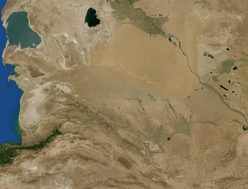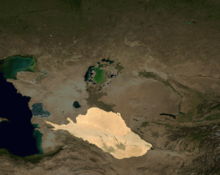Karakum Desert
The Karakum Desert, also spelled Kara-Kum and Gara-Gum (Turkmen: Garagum, pronounced [ɡɑɾɑˈɡʊm]; Russian: Караку́мы, tr. Karakumy, IPA: [kərɐˈkumɨ]), is a desert in Central Asia. Its name means Black Sand in Turkic languages, in reference to the dark soil that lies beneath the sandy surface of much of the desert.[1] It occupies about 70 percent, or 350,000 km², of the area of Turkmenistan.
| Karakum Desert | |
|---|---|
 Sand dunes in the Karakum Desert of Turkmenistan | |
 The Karakum Desert by NASA World Wind | |
| Area | 350,000 km2 (140,000 sq mi) |
| Geography | |
| Coordinates | 39°N 60°E |
The population is sparse, with an average of one person per 6.5 km² (one person per 2.5 square miles). Rainfall is also sparse, ranging from 70 to 150 mm per year.[2]
Geography
Covering much of present-day Turkmenistan, the Karakum Desert lies east of the Caspian Sea, with the Aral Sea to the north and the Amu Darya river and the Kyzyl Kum desert to the northeast. In modern times, with the shrinking of the Aral Sea, the extended "Aral Karakum" has appeared on the former seabed, with an estimated area of 15,440 sq mi/40,000 km². Although the level of the Aral Sea has fluctuated over its existence, the most recent level drop was caused by the former Soviet Union building massive irrigation projects in the region. Although the North Aral Sea is currently rising, the South Aral Sea is still dropping, thus expanding the size of the desert.[3]

In the late Pleistocene, the Amu Dar'ya used to flow through the Karakum to the Aral Basin and Sarykamysh Depression, but flooding in the Amu Dar'ya valley during a pluvial period resulted in overflow to the Zeravshan River valley. The Amu Dar-ya merged with the Zeravshan and eventually reached Horezm Lake. As the Horezm Lake, which had been formed by the earlier Khvalinian period, expanded northwards it linked with the Aral along the Akcha Dar'ya Corridor which created what is called the Akcha Dar'ya Delta.[4]
Environment
The sands of the Aral Karakum are made up of a salt-marsh consisting of finely-dispersed evaporites and remnants of alkaline mineral deposits, washed into the basin from irrigated fields.
Geology
The Karakum Desert is home to the Darvaza Gas Crater.
The area has significant oil and natural gas deposits.
Hydrography
To the south the Murghab and Tejen rivers flow out of the Hindu Kush Mountains, flow west, and empty into the desert, providing water for irrigation.
The desert is crossed by the second largest irrigation canal in the world, the Karakum Canal, which brings water from the Amu Darya to southern regions of the desert.[1] Construction on the canal was started in 1954 and completed in 1958.[1] It is 1,375 km in length, and carries 13-20 km³ of water annually.[1]
Archaeology
Within the Karakum are the Uly Balkan, a mountain range in which archaeologists have found human remains dating back to the Stone Age.
Features

The Darvaza gas crater, also called the "Door to Hell" or the "Gates of Hell" by locals, a crater of natural gas that has been burning since 1971, is located in the Karakum Desert. The crater is a major tourist attraction, with hundreds of visitors arriving each year.[5]
Transport
The desert is crossed by the Trans-Caspian Railway.
See also
References
- Scheffel, Richard L.; Wernet, Susan J., eds. (1980). Natural Wonders of the World. United States of America: Reader's Digest Association, Inc. pp. 199. ISBN 0-89577-087-3.
- "Karakum Desert -- Britannica Online Encyclopedia". www.britannica.com. Retrieved 2008-02-22.
- Aral Sea Archived 2009-03-16 at the Wayback Machine
- Razakov, RM (1996). The Aral Sea Basin. Springer. ISBN 978-3-642-64736-9. Retrieved 27 March 2019.
- Geiling, Natasha. "This Hellish Desert Pit Has Been On Fire for More Than 40 Years". Smithsonian. Retrieved 2017-06-19.
External links
| Wikimedia Commons has media related to Karakum. |
| Wikivoyage has a travel guide for Karakum. |